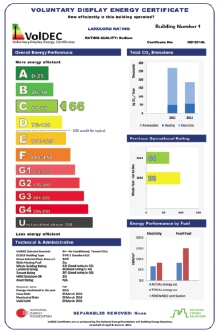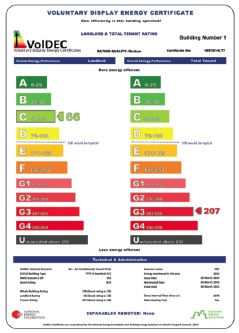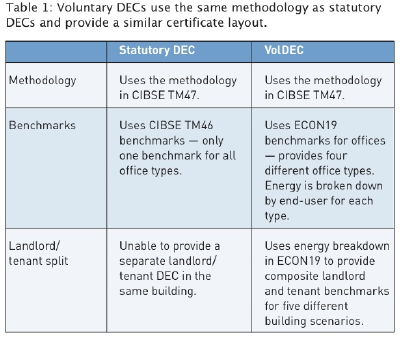Rethinking Display Energy Certificates

How do you assess the energy efficiency of a commercial office building and tackle the issues associated with the landlord and tenant energy split? Malcolm Hanna of the National Energy Foundation describes a potential solution.
There is a growing need for those responsible for buildings to monitor and manage their energy use better — whether because of the commercial bottom line, the ‘push’ of Government legislation and initiatives, the desire to combat climate change or the comfort and productivity of occupants.
Evaluating a building’s energy performance enables you to manage energy use better and identify and prioritise opportunities for energy-related improvements — whether they are capital investment, occupant education or building modifications.
It is often difficult, messy and complex to understand how much energy a building is using and how it breaks down into uses, time periods, zones and tenants. However, the old adage ‘if you don’t measure it, you can’t manage it’ applies, but many people responsible for buildings often don’t know what to measure, how to measure it, how often it should be measured or how to interpret the data. In short, there are many reasons for not taking action, or not taking it well!
The first stage of a prioritised energy-efficiency plan is to assemble key data and information about how the building stock is currently performing — annual energy use, cost data for each building, floor area, and, thereby, the annual energy use per square metre. Together with the building type (such as office, shop, depot etc.), you can then use this information to compare the performance of buildings across your own portfolio and, if appropriate, against published UK benchmarks for different types of building.
Comparing your buildings with one another and also with others of a similar design or use enables you to identify potential opportunities for improving energy efficiency and to prioritise further, more detailed investigations.
 |
 |
| A voluntary Display Energy Certificate for a tenanted building can focus on the landlord’s energy performance... | ...or it can compare the energy performance of the landlord and the tenant separately. |
The National Energy Foundation, working in partnership with Phil Jones of Building Energy Solutions, has recently developed VolDECs (voluntary Display Energy Certificates). This is a new initiative supported and piloted by Legal & General to help owners, managers and tenants to easily understand their energy use as the basis for action and improvement.
VolDECs are a new and innovative voluntary operational energy-rating scheme, initially designed for commercial office buildings. They are a not-for-profit scheme and are based on relatively simple data, making them inexpensive and quick to produce.
VolDECs came out of the fact that many commercial office buildings do not have an appropriate means of measuring and highlighting energy performance in a relatively simple and consistent way. In particular, there are issues associated with the landlord and tenant energy split and the lack of relevant benchmarks to enable performance to be measured and compared sensibly and consistently.
Our new approach separates tenant energy use from that of the landlord and the common parts of the building — thereby providing property owners and operators with cost-effective, user-friendly energy ratings for areas of a building that they control or manage, and are able to improve.
VolDECs use the same methodology as statutory DECs and provide a similar certificate layout (Table 1).
VolDECs also include the following additional features.
• Extended G scale to include G1 to G4, thereby providing low-ranking buildings with a more defined rating in order to encourage improvement.
• U (unclassified) rating for buildings where either performance or data is exceptionally poor.
• Certificate quality rating (high, medium and low) to encourage improvements in data quality.
VolDECs are now being further developed to include other elements such as waste and water, provide individual (floor by floor) VolDECs, serve other sectors such as shopping centres and to enable client input online.
Our aims with VolDECs include the following.
• Establish a consistent methodology and quality assurance across the industry.
• Provide a voluntary scheme without Government constraints.
• Provide a not-for-profit solution, for the benefit of the industry, backed by the industry.
• Use authoritative sector-specific benchmarks.
 |
• Highlight performance and encourage action and improvement.
• Conduct benchmarking research for the industry.
• Soft start the commercial sector into measuring performance.
• Encourage deeper analysis to benefit building operators, designers and the whole industry.
Various external and internal pressures mean that, for most organisations, the evaluation of energy performance is fast-becoming an unavoidable essential. Some see it as a burden but the more enlightened view it as providing benefits for all their stakeholders — from shareholders to employees to customers. VolDECs offer a host of benefits.
• Establish a consistent methodology and quality assurance across the industry.
• Provide landlords and tenants with comparative energy performance of the areas that they control.
• Highlight energy performance and provide a clear driver for improving performance.
• Are a stand-alone entry level engagement tool based on relatively simple data, making them easy to produce and inexpensive.
• Offer a starting point for tenant engagement.
• Use robust DEC methods, but with more appropriate benchmarks and an extended scale for greater performance differentiation.
• Have been piloted in 18 multi-tenanted offices, and are now being developed for other sectors and building owners, specifically retail.
• Help to highlight anomalies and the need for more detailed investigations.
Whilst you are likely to need external expertise for complex buildings and a detailed evaluation, VolDECs provide a useful, cost-effective and relatively easy starting point — and one you can build into a more sophisticated approach as and when your skills and confidence grow. NEF can also provide the statutory DEC rating for the whole building, if a further comparison is needed.
Malcolm Hanna is technical director of the National Energy Foundation.








